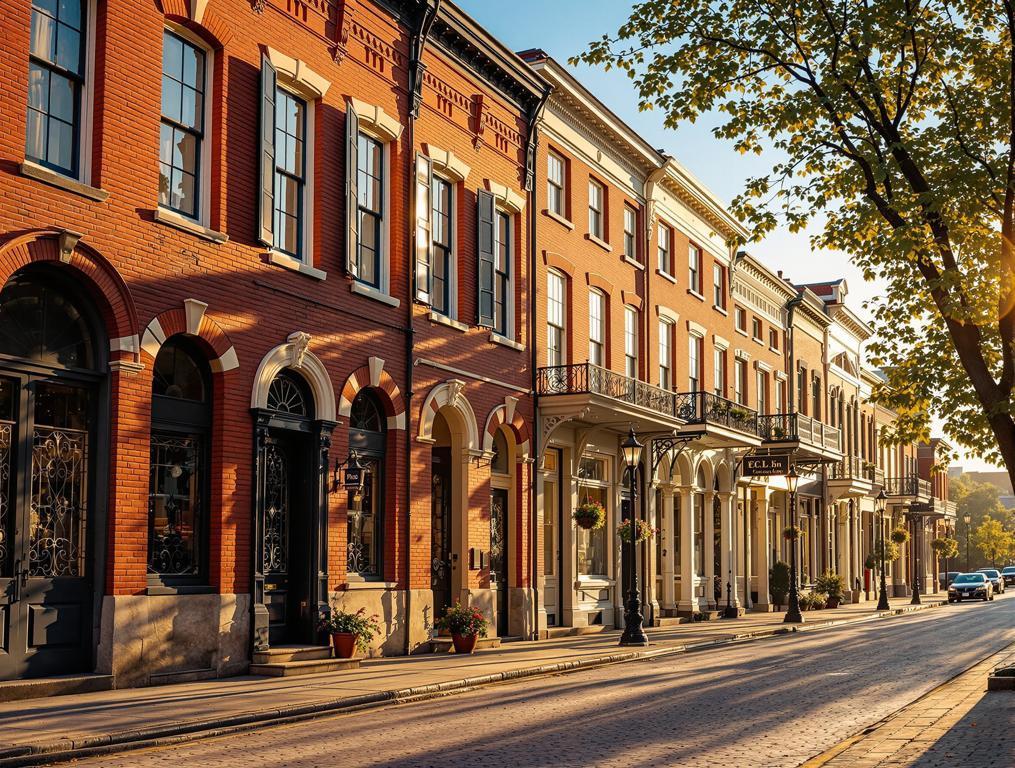I step onto Weston’s Main Street as the morning sun warms the red brick buildings. This isn’t just another small Missouri town—it’s a living museum where 30% of downtown structures predate the Civil War. With only 1,846 residents in 2025, Weston somehow maintains over 50 buildings on the National Register of Historic Places, creating the highest concentration of preserved pre-Civil War architecture I’ve seen west of the Mississippi.
As I trace my fingers along a weathered limestone foundation from 1842, I realize I’m standing exactly 30 miles northwest of Kansas City’s skyscrapers. Yet I might as well be in another century, walking the same streets where Jesse James and his gang once plotted their infamous bank robberies.
A town where 30% of buildings whisper pre-Civil War secrets
The mathematical improbability hits me: how did a town this small preserve such an extraordinary architectural legacy? While most American towns retain less than 5% of pre-1860s structures, Weston’s downtown boasts a preservation rate six times the national average.
“The Great Flood of 1881 was a blessing in disguise,” explains the curator at Weston Historical Museum. “When the Missouri River changed course, it left Weston high and dry—literally stranded from river commerce that had fueled its growth.” This economic pause essentially froze the town in time.
I wander past Italianate storefronts with original iron shutters and hand-carved cornices that would have been demolished decades ago in faster-growing cities. While Weston preserves its buildings through active use, other historic Western towns like Nevada’s mysterious abandoned castle town maintain their structures as time capsules.
In one afternoon, I count 17 pristine Victorian storefronts, 3 tobacco barns converted to artisan workshops, and an 1840s brewery still producing craft beers using historical recipes. The preservation isn’t museum-static but vibrantly alive.
Walking in Jesse James’ footsteps: Outlaw history preserved
Inside the Weston Historical Museum, a carefully preserved 1869 newspaper clipping details Jesse James gang movements through Platte County. The outlaw connection isn’t mere tourist bait—it’s documented history with physical evidence.
“You can feel it when you’re here—the sense that history happened right under your feet. Not sanitized like Williamsburg, but raw and real. I’ve visited twice this summer already.”
Just as South Dakota’s Sitting Bull burial site connects visitors to Native American history, Weston’s preserved buildings offer tangible links to Jesse James’ infamous frontier exploits. The difference? Here you can sip bourbon in the same spaces where outlaws once planned their next heist.
At the Holladay Distillery, founded in 1856, limestone cellars still bear markings supposedly left by gang members. The distillery tour guide points out a faded inscription that might—or might not—have been carved by Jesse’s brother Frank during a hasty retreat from lawmen.
Why summer 2025 reveals Weston’s hidden river experiences
Beyond architectural wonders, Weston offers summer experiences you’ll miss in more famous destinations. New Missouri River kayak tours launched in 2024 take visitors along routes once used by riverboat smugglers during Prohibition.
Weston’s summer events, while smaller in scale, carry the same local importance as New York’s historic bohemian festival town celebrations that preceded Woodstock by decades. The Summer Sunset Concert Series at Green Dirt Farm features acoustic performances with wine pairings amid rolling hills.
Wine enthusiasts tracking America’s historic vineyards might compare Weston’s emerging wine scene to Indiana’s Swiss wine legacy town where European traditions took root in the early 1800s. The difference is that Weston’s wineries sit atop limestone bluffs with 270-degree river views.
The ultimate 48-hour historic immersion (with winery bonus)
For maximum immersion, arrive Friday afternoon and book a room at the Saint George Hotel ($145/night), a restored 1845 inn with original floorboards that creak with historical authority. Request room 7 for the best river view.
Saturday morning, join the 8:30 AM walking tour when the architecture catches golden hour light. By afternoon, visit Pirtle Winery for its signature Norton varietal before catching sunset at Weston Bend State Park’s overlook.
Beyond architecture, Weston preserves traditional crafts and skills, similar to Kentucky’s craft village rivaling Tuscany in its dedication to maintaining handmade traditions.
As I drive away, glancing at Weston’s skyline in my rearview mirror, I’m reminded of what American preservation should be—not frozen behind velvet ropes, but living and breathing in buildings still serving their community. My daughter Emma would say Weston feels like stepping inside one of her history books, except here, you can touch everything.
